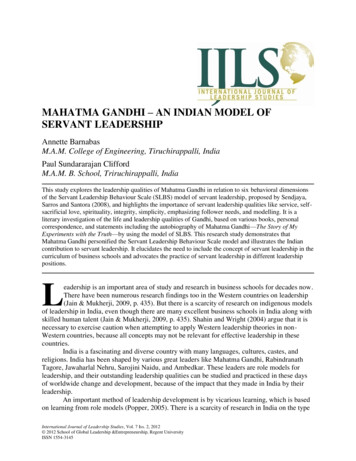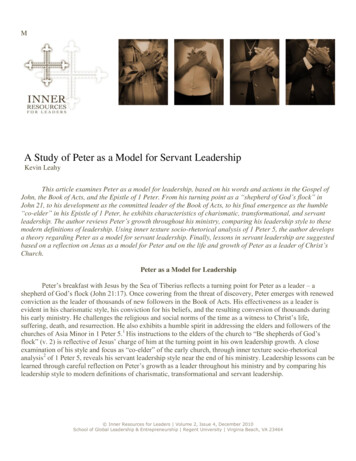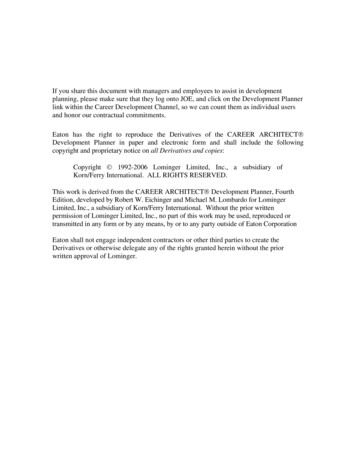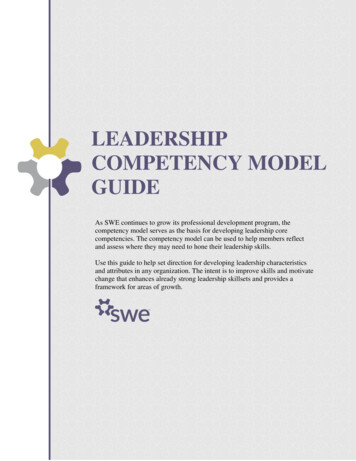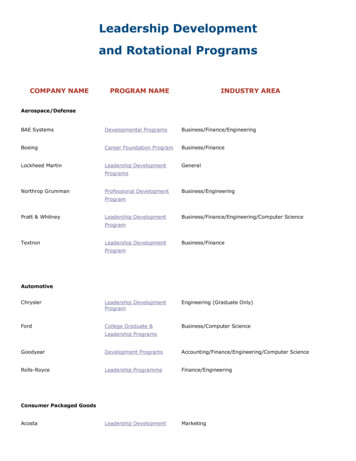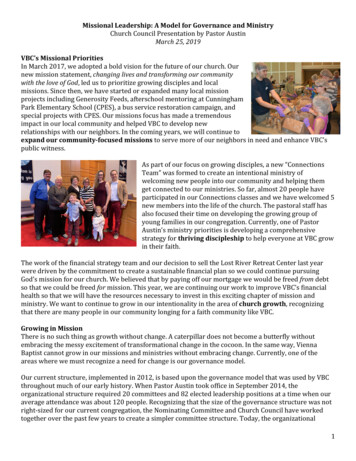
Transcription
Missional Leadership: A Model for Governance and MinistryChurch Council Presentation by Pastor AustinMarch 25, 2019VBC’s Missional PrioritiesIn March 2017, we adopted a bold vision for the future of our church. Ournew mission statement, changing lives and transforming our communitywith the love of God, led us to prioritize growing disciples and localmissions. Since then, we have started or expanded many local missionprojects including Generosity Feeds, afterschool mentoring at CunninghamPark Elementary School (CPES), a bus service restoration campaign, andspecial projects with CPES. Our missions focus has made a tremendousimpact in our local community and helped VBC to develop newrelationships with our neighbors. In the coming years, we will continue toexpand our community-focused missions to serve more of our neighbors in need and enhance VBC’spublic witness.As part of our focus on growing disciples, a new “ConnectionsTeam” was formed to create an intentional ministry ofwelcoming new people into our community and helping themget connected to our ministries. So far, almost 20 people haveparticipated in our Connections classes and we have welcomed 5new members into the life of the church. The pastoral staff hasalso focused their time on developing the growing group ofyoung families in our congregation. Currently, one of PastorAustin’s ministry priorities is developing a comprehensivestrategy for thriving discipleship to help everyone at VBC growin their faith.The work of the financial strategy team and our decision to sell the Lost River Retreat Center last yearwere driven by the commitment to create a sustainable financial plan so we could continue pursuingGod’s mission for our church. We believed that by paying off our mortgage we would be freed from debtso that we could be freed for mission. This year, we are continuing our work to improve VBC’s financialhealth so that we will have the resources necessary to invest in this exciting chapter of mission andministry. We want to continue to grow in our intentionality in the area of church growth, recognizingthat there are many people in our community longing for a faith community like VBC.Growing in MissionThere is no such thing as growth without change. A caterpillar does not become a butterfly withoutembracing the messy excitement of transformational change in the cocoon. In the same way, ViennaBaptist cannot grow in our missions and ministries without embracing change. Currently, one of theareas where we must recognize a need for change is our governance model.Our current structure, implemented in 2012, is based upon the governance model that was used by VBCthroughout much of our early history. When Pastor Austin took office in September 2014, theorganizational structure required 20 committees and 82 elected leadership positions at a time when ouraverage attendance was about 120 people. Recognizing that the size of the governance structure was notright-sized for our current congregation, the Nominating Committee and Church Council have workedtogether over the past few years to create a simpler committee structure. Today, the organizational1
structure requires 11 standing committees/groups and 52 elected leadership positions at a time whenaverage attendance is about 110 people.Although we have simplified the governance structure, it remains oversized and creates many burdenson church leaders. Problems typically arise due to the complex decision-making process and largenumber of people required to make management decisions. For instance, in the fall a chiller pump thatserved the Education wing’s HVAC system broke. The problem was identified by staff members who alsodiscussed the current building needs and possible interim solutions. The Building & Grounds Committeewas enlisted to retrieve three bids for a new chiller pump, the logistics of which required staffparticipation. Once bids and timelines were coordinated, the group sent their recommendation to theFinancial Administration Committee for review. The committee needed a full briefing on the nature of theproblem, solutions proposed, and bids reviewed in order to properly conduct their work. Since the priceof the repair required a special distribution of funds, a special Budget Council session was called toapprove repairs and funding. Then the staff, Building and Grounds chair, and a Church Trustee all had tocoordinate with one another for scheduling the repair and signing contracts. As a result, in total 35people, or one-third of a Sunday morning worship service, needed to be involved in the decision-makingprocess to restore cool air to the Education wing.1 If you are exhausted after reading this paragraph,imagine how our staff and lay leaders felt! As a church leader, perhaps you have your own stories ofnavigating our large committee structure in order to accomplish your work.The complexity of decision-making and the administrative burden of our current model are taking timeaway from the Lead Pastor’s and church leaders’ ability to focus on VBC’s priorities of communityfocused missions, thriving discipleship, and church growth. We must consider what is more important tous: our leaders spending time navigating bureaucracy or advancing our mission? If a change is not madein the near future, our church will not be able to devote the time and energy necessary to fulfill our boldstrategic goals for our church. As a result, this proposal is not about a governance change for its own sake.It is about building a leadership structure that best serves the church and advances our mission.Simply put, our goal is to create a governance model “kept as simple as possible so that it can functionefficiently, trying to allocate human resources wisely by forming committees that are not too large ornumerous for the congregation but large enough to allow for a democratic process.”2Organizing for MissionBefore presenting a renewed model for governance and ministry, it is important to recognize the recenthistory of governance change at Vienna Baptist. Since 2002, Vienna Baptist has undergone two significantgovernance changes: The first, implemented in July 2002, led to the team-based model and the creation ofthe Leadership Team. While the change alleviated the burden of an oversized organizational chart (148spots) and a complex committee structure (27 committees), it also produced unique challenges. Primaryconcerns were a lack of accountability at all levels, a lack of clarity in authority and decision-making, anda lack of transparent communication. The structure was also not able to provide effective leadershipduring times of congregational conflict and pastoral leadership transitions. As a result, in October 2013,the congregation approved the current organizational design, modeled after the 2001 OrganizationalManual.While we recognize a need for organizational change in order to invest in the growth of our mission andministry, our priorities for governance remain the same: clear and transparent leadership, mutualaccountability, efficient decision making, effective oversight, and congregation-based authority. Any4 staff members, 3 Building & Grounds members, 7 Financial Administration members, and 21 Church Council membersMaring, Norman H., and Winthrop S. Hudson. A Baptist Manual of Polity and Practice. Edited by David Gregg. 2nd ed. (Valley Forge, PA: JudsonPress, 2012), 141.122
proposal which does not meet these standards will not be approved by church leaders and thecongregation.A Renewed Model for Governance and MinistryA fundamental law of leadership is that no group rises higher or moves beyond its leadership. There aremany great resources devoted to helping churches and non-profits organize their leadership in ways thathelp the congregation climb higher and move closer to fulfilling God’s vision. The renewed model forgovernance and ministry outlined below relies heavily on two resources: Governance and Ministry:Rethinking Board Leadership (Second Edition) by Dan Hotchkiss and The Handbook of NonprofitGovernance published by BoardSource.Before examining the proposed model, it is important to establish a shared understanding of the keyterms and concepts that serve as the foundation for subsequent recommendations. We will use the figurebelow as a guide to our discussion.The Mission Comes First – The highest authority in our church is God’s mission for Vienna Baptist.Everything we do, from daily operational decisions to strategic mission priorities, is rooted in our sharedunderstanding of who God is calling us to be and what God is calling us to do. Our mission statement ofchanging lives and transforming our community is much more than a catchphrase; it is the standard bywhich we evaluate every decision in mission and ministry.Governance – Governance includes top-level tasks of articulating mission, selecting strategies for gettingthere, making sure the strategy is followed, and ensuring that people and property are protected againstharm. Governance produces mission statements, minutes, policies, strategic goals, and lists of core values.Ministry – Ministry is the daily work of building a community, managing resources, and changing lives.Ministry brings into being worship services, study groups, mission trips, service projects, mowed lawns,happy children, and renewed hope.Although it borders on oversimplification, a helpful summary may be that governance produces words onpaper and ministry produces action.3
Committees – Committees gather information, draft policy, or prepare in other ways to report back to thebody that appointed them. A committee is responsible to the Council (or to the congregation) and itswork product always goes back to its parent body.Teams – Teams exist to achieve practical results. They make important choices about how they willaccomplish ministry goals. A team is responsible to the staff, and its work product flows outward to thecongregation or to the world.Staff – For the purposes of our diagram, the staff includes ministers, administrative staff, program staff,and volunteer leadership positions. These are the leaders responsible for specific areas of ministry.Three Leadership Roles1. Oversight is the Church Council’s authority to hold the staff accountable. The Council is exercisingoversight when it reviews a financial audit, evaluates VBC’s progress toward its annual goals, ortalks with the Lead Pastor about performance. In oversight, more than any other aspect of itswork, the Council holds itself at a critical distance from the staff in order to give feedback from anindependent standpoint.2. Management is the staff’s authority to lead the work of ministry. Because all or almost all of thestaff’s management authority is delegated by the Council, the scope of management depends onthe extent of the authority the Council has delegated. Within its management authority, theCouncil expects the staff to make decisions and to take responsibility for them without asking forpermission or approval.3. Planning is envisioning a future (discernment) and making the big choices about how to get there(strategy). In contrast to oversight and management, planning is a “soft” kind of authority. To beeffective, planning depends on wide support from the Council, Diaconate, staff, top leaders, leadgivers, potential leaders, and active members. A planning effort might produce a missionstatement, a five-year strategic plan, or annual goals. After a wide process of discernment, plansflow to the Council and possibly the congregation for approval. Implementing plans—and makingmany choices about how to implement them—becomes a staff responsibility.You will also notice that the Diaconate serves a special role in the life of Vienna Baptist. The Diaconateoperates both in the sphere of ministry—by providing pastoral care—and discernment—as spiritualleaders considering God’s direction for VBC—placing them close to the center of the diagram. Throughtheir constant contact with church members, the Diaconate is in a unique position to serve as discernersfor the future of ministry.In a Baptist church, the congregation is the foundation for all of our work in governance and ministry.When elected to Church Council or participating in a business meeting, members of the congregationserve as overseers governing the life of the church. When church members participate in Town Halldiscussions, prayer groups, or other activities that focus on the future of the church they are discerningour future together. When members join a ministry team, serve as a deacon, or lead a mission actiongroup they are serving as ministers of the church. Ultimately, all authority and power in the church comesfrom and returns to the congregation as a whole.Regardless of the size or structure of our governance model, it is important for congregational health thatwe always maintain clarity about the role and function of each leadership body. Clarity allows churchleaders to focus on their own areas of responsibility and work together on shared goals for the sake ofour mission and for the good of the congregation.4
The Job of a Mission-Focused Church CouncilA Mission-Focused Church Council makes its most important contributions to the mission of the churchin three ways: by being a good partner to ministry leaders, by hosting ongoing conversation about thefuture, and by creating a sound structure of policy to regulate decision making.Creating and sustaining a strong partnership between itself and the Lead Pastor is one of the Council’smost crucial contributions. The Council has a unique opportunity to give support, feedback, advice,warnings, and encouragement to the Lead Pastor and to enhance his/her effectiveness as a result.Creating a good partnership is not a technical or legal project but a relational one. Ed Friedman famouslytaught, “when the chief lay person and the minister are together on things, that’s rooks back to back onthe chess board, that’s an impregnable posi
the Leadership Team. While the change alleviated the burden of an oversized organizational chart (148 spots) and a complex committee structure (27 committees), it also produced unique challenges. Primary concerns were a lack of accountability at all levels, a lack of clarity in authority and decision-making, and a lack of transparent communication. The structure was also not able to provide effective leadership

